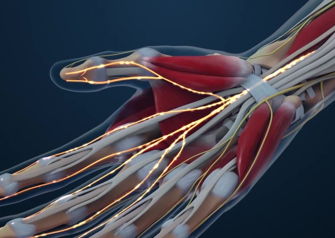
News
5 Things to Know about Carpal Tunnel Syndrome
Date posted: 11/7/2022
Last updated: 11/7/2022
Carpal tunnel syndrome is one of the most common conditions that we see as hand, wrist and elbow surgeons. It can often be confused with other disorders. Accordingly, it is important to understand the nuances of this condition in order to optimize diagnosis and treatment.
Carpal tunnel syndrome involves compression of the median nerve at the level of the wrist. The median nerve travels within the carpal tunnel, along with nine tendons that flex the thumb and other fingers. Beyond the wrist, the median nerve supplies sensation to the thumb, index, and middle fingers as well as half of the ring finger. It additionally supplies several muscles that control the thumb. When a nerve is compressed, there is a dynamic decrease in blood flow to the nerve and associated swelling within the nerve. This causes pain, numbness, and weakness. The ultimate goal of treatment for compressed nerves is to relieve this external pressure and thus restore the blood supply to the nerve.
We have found that the more patients understand their condition, the better they do. Thus, we want to share 5 points to know about carpal tunnel syndrome.
Your pinky is not involved
The median nerve supplies sensation to the thumb, index, and middle fingers as well as half of the ring finger. The pinky is not supplied by the median nerve and accordingly is not involved in carpal tunnel syndrome. When you get evaluated for hand numbness and tingling, we will always ask which fingers are affected. It is often difficult for patients to determine which specific fingers have symptoms, and they often state that their whole hand is involved. Next time you feel numbness and tingling, take your other hand to feel your pinky, or put your pinky on a table or the bed to see if it is truly involved. If it is, then you may have nerve compression other than carpal tunnel syndrome or in addition to carpal tunnel syndrome that we need to investigate further.
Nighttime symptoms are the most common
The most common presenting symptom of carpal tunnel syndrome is burning pain, numbness, and tingling that wakes you up at nighttime. You may often feel like you need to shake your hand out or hang it off the side of the bed. The reason this happens is that at nighttime, we often put our wrists in awkward positions such as flexing all the way down. These positions increase pressure within the carpal tunnel, causing symptoms. You may also experience symptoms during the daytime when the wrist is in positions of full flexion or extension, such as while driving or using a cell phone.
It may be from your neck
Numbness and tingling generally means that you have compression of a nerve. This compression can be anywhere along the nerve including the neck, upper arm, elbow, forearm, wrist, or hand. Compression of a nerve within the neck typically causes numbness and tingling that travels down the arm into the fingers. When you come see us in clinic, we will ask you if you have neck pain and how much of the arm is involved in your numbness and tingling. Most often, carpal tunnel syndrome tends to be limited to the hand itself and does not travel through the entire arm. Next time you have symptoms, pay attention as to whether you have associated neck pain or have symptoms involving the arm as well. When we see you, we will determine where the numbness and tingling is coming from and make sure it is addressed appropriately. If there is any uncertainty as to where the nerve compression is coming from, we can obtain a nerve test to better isolate the area of compression.
You can get weakness or constant numbness if it goes untreated
If carpal tunnel syndrome is not treated appropriately, it can lead to constant numbness in the fingers and weakness in the muscles supplying the thumb. This is due to worsening nerve degeneration that comes with increased compression, which further decreases blood supply to the nerve and causes swelling and scarring. You may find yourself dropping objects or have difficulty performing fine motor tasks as time goes on. It is important to get evaluated in a timely manner so that you can get the appropriate treatment before the condition gets to this point. When you get evaluated for this condition, we will ask you if your symptoms are constant or if they come and go. We will also check the strength of your hand.
There is reliable treatment
When carpal tunnel symptoms are mild and have been going on for a short amount of time, we initially recommend sleeping with a wrist brace. The purpose of the wrist brace is to keep the wrist in a relatively neutral position so that you can avoid positions that increase pressure on the carpal tunnel. There are also some ergonomic changes you can make to avoid positions of extreme wrist flexion and extension during the daytime. You can use a keyboard and mouse cushion to keep your wrist in a neutral position, or you can try using a vertical mouse. We ideally would like to relieve pressure on the median nerve before it gets to the point of constant numbness or weakness because once it gets to this point, the amount of nerve recovery after the carpal tunnel release is not as predictable. We therefore recommend surgery when the night bracing doesn’t work, if symptoms have been ongoing for over a year, or if the carpal tunnel syndrome is already severe to the point that there is constant numbness or weakness. Surgery involves releasing the transverse carpal ligament, which is the roof of the carpal tunnel. The primary goal of the surgery is to relieve the compression on the median nerve and restore the blood supply to the nerve.
If you are having numbness and tingling in your hand, we encourage you to get evaluated so that you can get the appropriate diagnosis and treatment. We look forward to meeting you and helping you get back to more restful nights.
About Dr. Nitin Goyal
Dr. Nitin Goyal is a fellowship-trained orthopedic surgeon specializing in care of the hand and upper extremity. Originally from Naperville, Dr. Goyal graduated with honors (Summa Cum Laude) in Economics from Northwestern University, where he was inducted into the Phi Beta Kappa Honors Society. He received his medical degree with honors (Cum Laude) from Northwestern University Feinberg School of Medicine. Dr. Goyal completed his orthopedic surgery residency at Rush University Medical Center, where he received the Surgical Specialty Intern of the Year Award and was selected to attend the AOA Resident Leadership Forum. After that, Dr. Goyal completed his hand and upper extremity fellowship at the University of Pittsburgh Medical Center.


